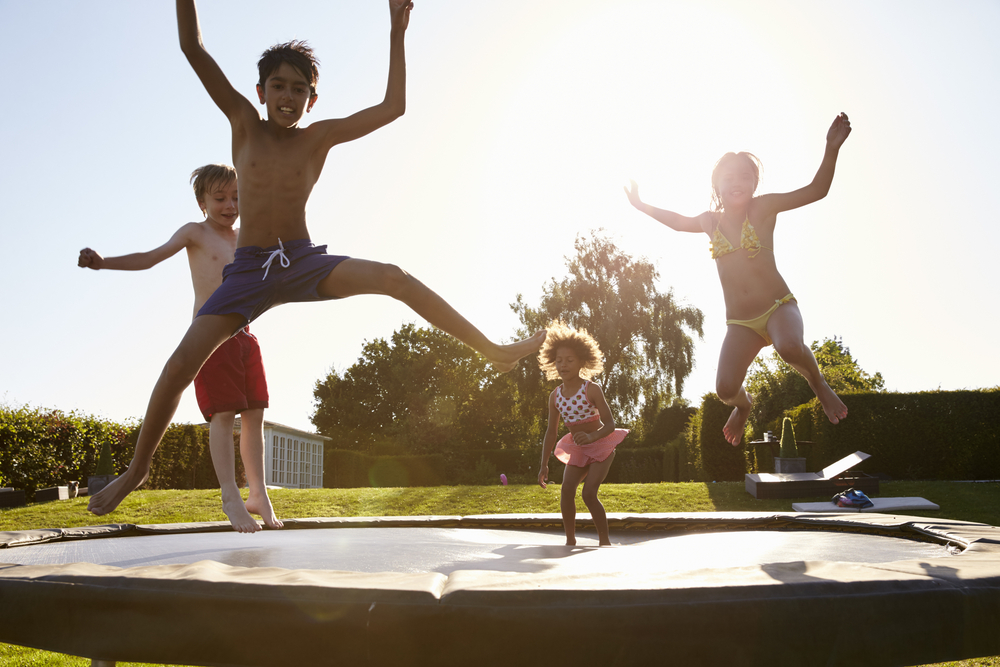If your children love trampolines, they’re in the majority. Trampolines are a great way to get them outside, active and away from TV monitors.
Unfortunately, as with every physical activity, trampolines can cause injury and pose a unique list of potential dangers. The U.S. Consumer Product Safety Commission reports over 100,000 trampoline-related injuries annually. Children made up more than 90 percent of these injuries and over three-quarters occurred with multiple occupants on the trampoline. Most of the injuries came from landing on the trampoline mat, frame or springs, somersaults and flips gone wrong, and falling off the trampoline. These injuries can turn into sprains and fractures to limbs, and a faulty flip or somersault can lead to permanent, potentially fatal head and neck accidents.
Here are some tips to prevent these injuries from occurring.
Buy padding for the springs and frame (possibly a springless trampoline)
Landing one the frame is one of the leading causes of trampoline injuries. Placing a protective padding over the spring in frame can help shield trampoline occupants and protect the springs from damage as well.
Keep your trampoline away from bushes, landscape or other hazards
Try to keep these hazards away from the trampoline. Landing on the hard ground is one thing, but hitting trees or landing on fences can lead to a handful of additional and more severe injuries.
Buy a trampoline safety net
A trampoline net can help ensure no one will fall off and injure themselves. Safety nets are especially important if you must place the trampoline close to trees, fences or other hazardous objects. Make sure that no one jumps high enough to go over the net. Not only can this lead to injury but the sheer height of the net will certainly mean more severe injuries if someone falls from that height.
Inspect the trampoline before jumping
Make sure springs are intact, bolts are tight and the frame has no corrosion. Faulty springs can actually fly off the trampoline when in use, hitting occupants or bystanders, and loose bolts and corrosion can cause the game to collapse.
Have your children take a quick look at the trampoline before using it and alert you of any concerns. Children can be negligent at times, so it doesn’t hurt to take a few minutes out of your day to inspect it yourself as you pass by.
Remove jewelry or anything that can catch
Children are forgetful, but it’s important to remind them to remove any jewelry they have on as landing on it, ripping out piercing or catching a necklace can lead to painful injuries. This includes jewelry in their pockets as well. To promote this, consider placing a small tote next to the ladder to remind them every time they board the trampoline.
Always use the trampoline ladder
Sometimes the simplest of tasks can lead to injuries. While the majority of injuries are caused by the frame and spring, but even falling through can do harm as well. Simply using the step ladder is a safe way to minimize injury.
Keep the trampoline on level ground and on ground level
This is twofold. First, make sure the trampoline is on level ground. An unbalanced foundation is certain to cause injury. Second, place the trampoline on ground level. A fall off the trampoline is already painful, but placing a trampoline on a slightly higher ground increases the force of the impact.
Install padding around the trampoline
Placing some cushion on the ground around the trampoline might seem unnecessary or extra, but its significantly cheaper than a hospital bill. Another idea is to place the trampoline in a sandy area, with sand extending slightly beyond the trampoline’s circumference. The sand can provide extra padding in case of any falls.
Follow age and size restrictions
The age and height restrictions are there for a reason. A maxed out or overcapacity trampoline can break or age faster at the very least. In addition, age restrictions are in place for coordination and bone density purposes. Any child under the age is likely not developed enough to safely use the trampoline.
Store it properly
Winter climate can have a lasting impact on the trampoline. The frame and springs might not react well to the cold and any snowfall on the canvas will provide added weight that is certainly heavier than the trampoline’s limitations. In addition, this added weight is just sitting there and will contribute to significantly more damage than an overweight user.
Never jump alone
Just like swimming, jumping alone is dangerous. Without anyone available to apply first aid or call for emergency personnel, lone occupants place themselves in a significant danger.

